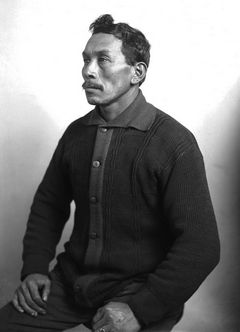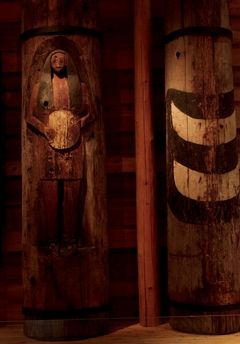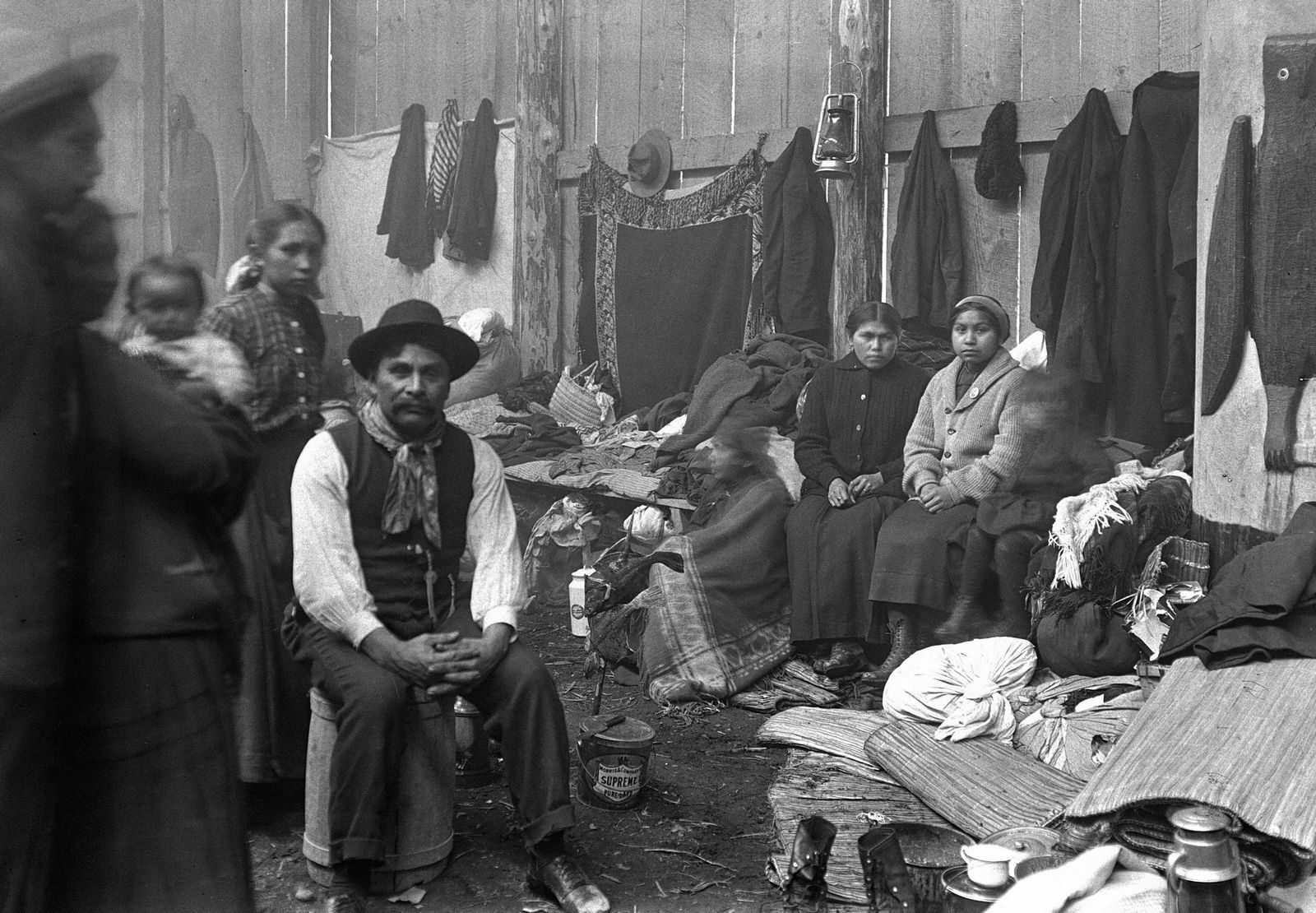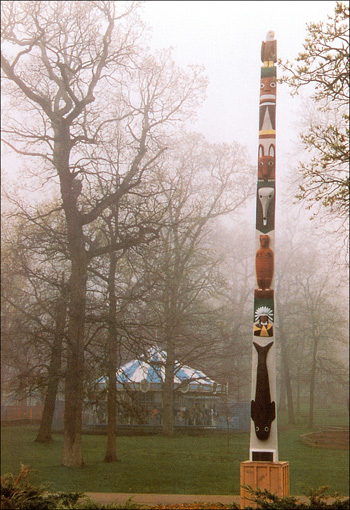William Shelton Pole Tulalip Elem H.264 from Tulalip News on Vimeo.
Tag: William Shelton
Culture Bearers: 5 Carvers Who Kept Northwest Coast Carving Alive, Part 1
From the late 1800s until 1934 in the U.S. and 1951 in Canada, the potlatch—the great system of celebration, honoring, witnessing, and wealth redistribution—was banned in an effort to kill indigenous cultural ways. Potlatch-related activities, such as carving, were banned. Authorities confiscated regalia. People who went to potlatches were arrested and jailed. And yet, the cultural ways survived.
Among those who defied the unjust laws of the time were the artists who continued to carve regalia masks, house posts, great totem poles, and sea- and ocean-going canoes. Here’s a list of some of the carvers and their artistic heirs whose legacy is a culture that is living and thriving. This list is by no means complete.
Charles Edenshaw, Haida (1839-1920) For three months this year, the National Gallery of Canada exhibited 80 objects created by Edenshaw, calling him “one of the most innovative artists working on the West Coast at the turn of the 20th century.”
He was in his mid-40s when Canada’s anti-potlatch laws were enacted, yet, according to the National Gallery, his “deep-seated belief in Haida traditions … gave him the agility and fortitude to thrive as a Haida artist during oppressive colonial rule.”
His works included bentwood boxes, masks, rattles, staffs and totem poles. He advanced gold and silver engraving in traditional formline design. He had, the gallery wrote, an “ability to animate Haida stories in his carving.” He was interested in new materials and visual ideas and, according to the Dictionary of Canadian Biography, may have been the first Haida artist to work in silver and gold.
Edenshaw produced many commissioned works; major collections of his works are housed in museums in Chicago, New York, British Columbia, Quebec, and Oxford. His drawings were published in the anthropologist Franz Boas’s 1927 book, Primitive Art. And his work was first exhibited as “fine art” in 1927 by the National Gallery of Canada in Ottawa; the exhibit later travelled to the Musée du Jeu-de-Paume in Paris.

Chief John McCarty, Makah (c. 1850- unknown) McCarty, whose Makah name was Hishka, was a hereditary chief whose uncle signed the Treaty of Neah Bay in 1855. Hishka carved canoes used in whaling and sealing and “had a whaling canoe of his own,” said John McCarty, Hishka’s namesake and grandson. He said a sealing canoe carved by his grandfather still existed in the 1950s.
Hishka also created a large Thunderbird with moveable wings and beak, which was used to tell the story of how Thunderbird captured a whale for food. Hishka’s grandson and great-grandson made a similarly dramatic presentation when the Makah Nation hosted the 2010 Canoe Journey: they created a large whale with moveable fins, eyes and mouth. Singers sang a song to wake up the whale, its eyes opened, and dancers came out of the whale’s mouth.
Hishka’s descendants continue his legacy of service to the Makah Nation—his son, Jerry, served as chairman. His namesake grandson served as director of the Makah Whaling Commission and dances the chief’s song he inherited from his grandfather, and his great-grandson, Micah McCarty, served as Makah Nation chairman.

Charles Edwards, Samish (1866-1948) The Samish Indian Nation had “a reputation for its skilled craftsmen,” historian Bret Lunsford wrote in his book, Anacortes. To that reputation, Edwards contributed The Telegraph, a famous racing canoe carved circa 1905, now on display at a museum on nearby Whidbey Island; the Question Mark 2, a racing canoe carved in 1936 after the original Question Mark went into retirement (it now resides in Virginia); and a 60-foot pole in 1938 that depicted important cultural figures.
The 1938 pole was removed in 1981; the carved images were restored and are on display in the Swinomish Tribe’s social services building. Swinomish artist Kevin Paul carved a replica pole that was raised in 1989.
Edwards was also a leader and advocate for Native treaty rights. He represented the Samish before the U.S. Court of Claims in 1926 in Duwamish, et al Tribes of Indians v. United States. His son, Alfred, served as chairman of the Samish Indian Nation. A great-granddaughter, Barbara James, is treasurer and former vice chairwoman of the Swinomish Tribe.
William Shelton, Snohomish (1869-1938) At a time when his people were disallowed from speaking their language and practicing their customs, Shelton devoted his life to preserving and sharing the traditions of the Snohomish people through art, public presentations, and his book, The Story of the Totem Pole or Indian Legends, written at the Bureau of Indian Affair’s request. (The book was republished in 2010 by Kessinger Publishing, which specializes in rare, out-of-print books.)

Shelton’s works included a longhouse and a story pole on the Tulalip Reservation; a story pole commissioned by residents of the City of Everett; a 37-foot story pole for a park in Freeport, Illinois; and a story pole, requested by his state’s governor, for the state capitol grounds.
In 1931, he was a speaker at the dedication of a bronze and granite marker commemorating the 1855 signing of the Point Elliott Treaty; other speakers included a member of Congress and the governor.
Shelton passed away before his final pole was finished and the work was completed by other Tulalip carvers. There was some symbolism in that; historian Margaret Riddle wrote on HistoryLink.org that Shelton’s accomplishments “served as the bridge for following generations who found new ways to continue his work.”

Mungo Martin, Kwakwaka’wakw (1879-1962) Martin was raised in the potlatch tradition of the Kwakwaka’wakw and hosted the first public potlatch since his government’s potlatch ban of 1884. His career was long and prolific; he carved his first commissioned totem pole in Alert Bay around 1900.
In 1947, Martin was hired by the Museum of Anthropology at the University of British Columbia to restore and create replicas of sculptures, totem poles, masks and other ceremonial objects. Between 1952 and 1962, he created new and replica poles for Thunderbird Park at the Royal British Columbia Museum in Victoria. Among his monumental works: Wawadit’la, a Kwakwaka’wakw big house; a 160-foot totem pole that remained standing until 2000; and the Centennial Pole, presented to Queen Elizabeth to commemorate the 100th anniversary of the founding of British Columbia. This pole stands in Windsor Great Park near London.
In his later years, Martin sang and recorded songs, and prepared novices for Kwakwaka’wakw ceremonies.
Martin’s descendants include some of the most accomplished Northwest Coast Native artists: Richard, Tony and Stanley Clifford Hunt are his grandsons; Shirley Hunt is a granddaughter; Jason and Trevor Hunt are great-grandsons.

William Shelton revived Tulalip culture

By Bill Sheets, The Herald
TULALIP — When it came to healing the rift between local Indian tribes and the white world that once stripped Snohomish County’s original inhabitants of much of their culture, there has been no more important figure than William Shelton.
Early in the 20th century, Shelton worked hard to restore and preserve early tribal traditions that had been banned on the Tulalip Indian Reservation for decades.
At the same time, he offered an olive branch to the non-tribal community, reaching out to speak at club meetings and schools. He attended fairs and gave radio interviews.
He served as an ambassador, a liaison between the two worlds.
A Tulalip tribal member, a historian and a filmmaker recently joined forces in hopes of making a documentary to spotlight Shelton’s effect on local tribal and non-tribal culture alike.
“I really think that people need to know about William Shelton,” said Lita Sheldon, the tribal member spearheading the project.
Her goal, she said, is to make an hour-long documentary to air on the History channel, Biography channel or PBS.
Sheldon, along with Everett-based historian David Dilgard and Bellingham video producer Jeff Boice, started the project in 2012 with a short video overview of Shelton’s life.
The 11-minute video, supplemented with historical photos and footage, features an interview with Dilgard in which he describes how Shelton revived tribal art on the Tulalip reservation by carving his “sklaletut” pole in 1912.
Shelton interviewed tribal elders about their encounters with spirit helpers, including animals, birds and people, and depicted them in carvings on both sides of a 60-foot pole.
Sklaletut is the word for spirit helpers in Lushootseed, the language of Puget Sound-area Indian tribes.
“There is a broken link between my race and the white people,” Shelton wrote in “Indian Totem Legends of the Northwest Coast Country” in 1913, an article originally printed for an Indian school in Oklahoma and later in The Herald.
“So I thought I better look back and talk to the older people that are living and try to explain our history by getting their totems and carve them out on the pole like the way it used to be years ago,” Shelton wrote.
The pole has deteriorated over the years, but part of it still stands in front of Tulalip Elementary School on the reservation.
Shelton carved several other poles, including one that stood for decades at 44th Street SE and Evergreen Way in Everett — for which the Totem restaurant was named.

These two poles carved by William Shelton stood in his original longhouse and now are at the cultural center.
The pole deteriorated and was taken down in the late ’80s or early ’90s. It’s now being preserved in a warehouse on the Tulalip reservation.
About 200 of the 1,000 items in the collection of the recently built Hibulb Cultural Center either were made by Shelton or came from among other items stored on his family’s property, assistant curator Tessa Campbell has said.
Shelton ran the sawmill on the reservation and served as a translator for tribal elders who did not speak English. He supervised timber sales, served for a time as police chief and sold war bonds during World War I.
He spoke at the dedication of Legion Park in Everett shortly before his death from pneumonia in 1938 at age 70, according to the city.
In the 1990s, Lita Sheldon worked with Boice, the filmmaker, on short historical and Lushootseed language videos on the reservation.
Boice, a former videographer, editor and producer at KVOS-TV in Bellingham, did freelance video work for the Tulalips for several years, including recording tribal events.
Recently, Sheldon contacted Boice and Dilgard about her idea and the short video was made. The video won best overall film and best documentary short film at the Hibulb Cultural Center Film Festival last January.
Later, it was shown at the American Indian Film Festival in San Francisco in November and at the Red Nation Film Festival in Los Angeles, Sheldon said.
Sheldon said she needs to raise about $60,000 to fully fund the documentary. The cost would include travel to locations in the East and Midwest where William Shelton sent some of his poles, she said.
The film project had a “kickstarter” web page last summer but received only a little more than $2,800 in pledges, so the idea was shelved temporarily.
Sheldon hasn’t given up, though. She said she hasn’t asked the Tulalip Tribes for funds.
Niki Cleary, a spokeswoman for the tribes, said the project could be eligible for funding as a tribal endeavor, but Sheldon’s group would have to apply. The group also could gain nonprofit status and apply through the tribes’ annual charitable contribution program, she said.

The Tulalip Longhouse interior is shown during a “Treaty Day” celebration in January 1914. Posts inside the longhouse were ornamented by William Shelton with clan and family symbols.
Lita Sheldon, 61, works as the librarian at the Hibulb center but stressed that she is doing this project on her own.
She said it’s not just a matter of money but also of gathering more information about the former tribal leader.
Much of the history about Shelton came through his daughter, Harriette Dover, who died in 1991, as well as from other surviving relatives.
Sheldon is hoping more people with knowledge of William Shelton come forward.
“There’s not a definitive tribal history written,” she said. “This is the closest thing to a tribal history.”
The project
Anyone interested in the William Shelton documentary project may contact Lita Sheldon at litasheldon@yahoo.com.
Telling Tulalip’s Story

By Monica Brown, Tulalip News Writer
TULALIP, Wa – Tulalip’s Hibulb Cultural Center, on occasion, feature film screenings of films that star, are filmed by or are written by Native Americans, yet all tell one facet of the Native American life. Thursday, Oct 24th’s featured screenings were of Jeff Boice’s work with the Tulalip Tribes. Jeff Boice, a videographer/editor, has been working with the Tulalip Tribes since 1990, has also done video shootings for large media companies such as The Discovery Channel and CNN.
The evenings screening were many short segments of the Walking Tour II with Ray Moses, History Minutes and a Williams Shelton’s segment. The Walking Tour follows Tulalip tribal member Ray Moses as he tells stories about significant locations on the Tulalip reservation. “He’s quite a historian. It was great working with Ray,” commented Boice.
History Minutes are under a few minutes, are produced for the museum and focus on one particular aspect of tribal life such as boarding school life or construction of summer homes that were used in the old days.
The William Shelton segment centered on the portion of William’s life when he carved the Sklaletut pole, a culturally important piece of artwork. Boice has a genuine interest in documenting the past of the Tulalip Tribes and states, “Our hopes are that this video will help generate enough interest to be able to do a longer documentary [on William Shelton] but not just that but to generate interest in preserving the Sklaletut pole.”
Most screenings events at the Hibulb are relatively intimate, are under a few hours and include a Q and A afterwards. For more about future film screenings at the Hibulb please visit their website or call 360-716-2600. To view the works of Jeff Boice, visit Boicetv.com.
After nearly 80 years, Native American story pole is coming home

By Kiersten Throndsem, kimatv.com
SEATTLE – For more than 70 years a pole stood watch over a Boy Scout park in Freeport, Ill. This pole shared a story, carved in wood, of a Native American culture to those who visited the park until it was removed.
And, now the Burke Museum wants to bring this story pole – created by in the Northwest by Snohomish Tribe leader William Shelton — home.
“It’s an important pole for us because we don’t have a pole from that period,” said Robin Wright, with the Burke Museum. “William Shelton really initiated the totem pole carving for the Coast Salish.”
After being carved by Shelton, the 37-foot pole was sent to Illinois in 1935. There it stood in Krape Park until 2008 while weather and bugs led to its decay. The story pole was taken down five years ago and has remained in a warehouse ever since.
“The bottom of it where it went into the ground is completely rotten, and other portions of the pole need some loving care,” Wright said “It’s in pretty poor condition.”
Not sure what to do with the pole, the Freeport Park District contacted the Burke Museum to see if it might be interested in taking it. The museum is home to a large Northwest Coast collection and very familiar with works of Shelton and the Coast Salish culture.
However, getting the pole here is tricky and will cost thousands of dollars. To help offset some of those moving expenses, the museum turned online, to a crowd sourcing fundraiser in hopes of raising $7,500. The money will help pay for a truck and flatbed trailer to haul the pole across the country.
Shelton is recognized for carving a number of poles between 1910 and the 1930s, and this particular pole, Wright said, tells the same kind of story found on all his poles.
“The whale at the bottom and the eagle at the top” Wright said. “Whales are very important for the original story of the Tulalip Tribe. It goes back to a time when people were starving and whales would help herd the salmon up the stream so people could get food.”
The Burke Museum plans to work with representatives from the Tulalip Tribe, as well as Shelton’s family, who happen to live in Snohomish County, to interpret the pole once it arrives. It’s unknown how much it will cost to actually restore the pole, and it will need to be fumigated. The hope is to hire Tulalip carvers trained in story pole restoration.
Shelton’s pole will be tallest pole in the museum’s collection and will be mounted inside.
More information about the museum’s fundraising efforts can be found online.




